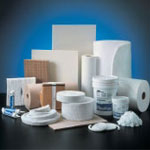 With its impressive high-temperature stability, ceramic fiber isn’t just any ordinary material. Its derivatives, like ceramic fiber blankets, boards, and paper, have revolutionized heat management in numerous industries ranging from aerospace to energy. But what makes ceramic fiber so unique? And why is its role in modern engineering and technology growing so rapidly? To unpack it all, Armil CFS delves into the world of ceramic fiber products to better understand their properties and applications.
With its impressive high-temperature stability, ceramic fiber isn’t just any ordinary material. Its derivatives, like ceramic fiber blankets, boards, and paper, have revolutionized heat management in numerous industries ranging from aerospace to energy. But what makes ceramic fiber so unique? And why is its role in modern engineering and technology growing so rapidly? To unpack it all, Armil CFS delves into the world of ceramic fiber products to better understand their properties and applications.
The Nature of Ceramic Fiber
Ceramic fibers, often recognized for their inherent resistance to elevated temperatures, are essentially small-diameter fibers made up of ceramic materials. These fibers sometimes spun to create spun ceramic fiber, originate from elements like alumina, silica, or a mix of both. This composition imparts a unique set of physical and chemical properties that place ceramic fibers in a league of their own.
One of the primary attributes of ceramic fibers is their extraordinary thermal stability. Unlike many materials that degrade or melt under extreme heat, ceramic fibers maintain their integrity in environments exceeding 2,000°F. This excellent resistance to heat makes them indispensable in high-temperature applications, such as furnace insulation or kiln linings.
In addition to their thermal properties, ceramic fibers are lightweight with exceptional tensile strength. Their low thermal conductivity makes them effective insulators, keeping heat contained or excluded as required. Furthermore, their resistance to thermal shock and corrosive chemicals ensures longevity, even in fluctuating temperatures or places where aggressive chemicals, like those in a glass furnace crown insulation, are in play.
Industries that Harness the Power of Ceramic Fiber
As we delve deeper into the world of ceramic fiber and its multifaceted properties, one might wonder: Where does this material fit into the respective industries that utilize it?
From the infinite stretches of space to the intense environments of power plants, ceramic fiber stands as a beacon of resilience and efficiency. Below are some prominent industries where ceramic fiber is not just an asset but a necessity.
Aerospace and Aviation: The need for efficient thermal insulation is paramount within the vast expanse of space or the intense pressures of atmospheric re-entry. Ceramic fiber modules, blankets, and boards have been employed in everything from the insulation of space shuttles to the protective layers of aircraft.
Energy Production: Power plants, especially those focusing on renewable energy, require materials with low heat storage capacities. Ceramic fiber insulation, in the form of blankets or fiber modules, ensures efficiency and safety.
Petrochemical Industry: The fiery processes involved in petrochemical refining necessitate materials with high-temperature resistance. Ceramic fiber boards, paper, and related products like seals and gaskets come into play, safeguarding infrastructure and optimizing processes.
The Vast Horizon of Ceramic Fiber
As we push the boundaries of what’s possible, the myriad of ceramic fiber products, from boards to blankets and even ceramic fiber cloth, promises a future where heat treatment processes and fire protection systems can continue to benefit from these advanced materials. Their unique properties make them essential components in modern industry and technology. With ongoing research and innovation, there’s little doubt that ceramic fiber’s properties will continue to shape the technologies of tomorrow.